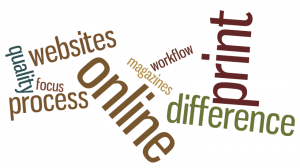In a rare but welcome turn of events, this week I read three thoughtful deep dives about content management systems.
1
I found myself nodding a lot at this Mediashift piece that discussed how magazines can better use analytics to determine their digital focus. Some highlights:
“We watch numbers on each of these platforms and determine what platforms can have a rich workflow and rich experience, and where we want to enhance the content with video. We also have replica editions where people are happy with just a flipbook. We make decisions on a per-platform basis [by considering] the return on investment of any of these.” —Kerrie Keegan, Reader’s Digest
“All of the different platforms — not even just production platforms like Mag+, Zinio, Adobe DPS, but also Apple versus Google versus Amazon versus Next Issue — all of those have a different set of analytics and metrics that can be obtained. Those really differ widely. It’s one of the core challenges for anybody trying to publish in this space and across those markets…. The challenges aren’t really technical at this point. The challenges are what I call infrastructure. In print, we all know what rate base is, what CPMs are going to be, what metrics we pay attention to. We don’t have the same infrastructure for monetizing digital. From an advertising point of view, does rate base matter, or is it interaction, engagement, time in app?” —Mike Haney, Mag+
2
This excellent piece from Neiman Lab gets into the inner workings of Scoop, the New York Times‘s CMS, with Luke Vnenchak. The parts I found most interesting had to do with something I always advocate: better integration of basic editorial functions, such as, oh, I don’t know, editing words, into CMSes.
Scoop incorporates a number of real-time editing options that might look familiar to Google Docs users. Different team members can work on different parts of a story at the same time: “For example, a reporter can work on the article while an editor is writing the headline and summary and a producer is adding multimedia. But one editor can’t work on the headline while another works on the summary.”
Isn’t it amazing that this very basic functionality is so hard to come by in most off-the-shelf CMSes? Additionally, for being content management systems, most CMSes are abysmal at actually managing content in the editorial sense:
One thing that is always handy in newsrooms is a system for tracking the status of stories as they move from assigning and writing to editing. Beyond knowing the status of an article, Vnenchak said they want the system to track when stories run online and in print, and how a story is performing once it’s published.
Our asks as editors are quite standard, if not primitive, from a content-making standpoint. Something as essential as status tracking being incorporated into a CMS should be common, not rare.
3
Finally, an intriguing post that could indicate the end of cobbled together, homegrown editorial CMSes. Much can be said about Google, but even its detractors have to admit that when the company puts its mind to doing something, it gets done. That something might soon be a CMS “that would unify editorial, advertising and perhaps commerce activities for media companies.”
The so-far-untapped opportunity that Google is chasing — articulated with greater frequency this year in ad tech circles — is to take a holistic approach to managing yield that spans multiple publisher revenue sources and screen form factors.
The idea that a editorial-based, unifying CMS hasn’t yet been developed is rather shocking in itself. But the arguments the article makes against Google developing such a product are the pinnacle of self-reproach and shame. It’s almost as though all of online publishing has been told by its shrieking mother, “This is why we can’t have nice things!” and internalized the message:
A CMS could be a tough sell for Google, especially as a number of publishers have lately staked their future on the strength of a proprietary CMS. Three prominent examples are Vox Media, whose vaunted Chorus CMS is considered its secret sauce, BuzzFeed, which has baked native advertising into its content platform, and The New York Times, where technology-powered storytelling is seen as core to its editorial and advertising mission. For such publishers, adopting a CMS from a large platform player like Google would be tantamount to outsourcing the very notion of innovation.
Additionally many established publishers have customized their content tools to integrate with legacy publishing systems. Many publishers use multiple CMSs, for instance a custom platform powered by Drupal alongside WordPress for blogging. So there’s a big technical hurdle to adopting any off-the-shelf solution Google has on offer. That’s setting aside the technical and human resources barriers required to migrate away from “good enough” content systems.
This last part reminds me of the great Aimee Mann song “Momentum”: “But I can’t confront the doubts I have/I can’t admit that maybe the past was bad/And so, for the sake of momentum/I’m condemning the future to death/So it can match the past.”
It seems obvious that we should embrace enhancements to CMSes for editorial, be they analytics, metrics, platforms, workflows, or appropriate ad-edit collaboration.
